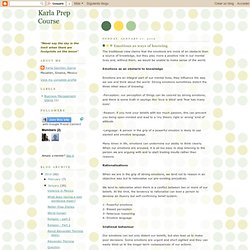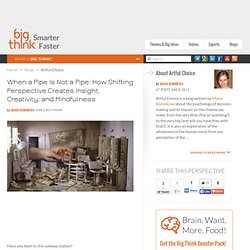

Language Appears to Shape Our Implicit Preferences. Emotions as ways of knowing. The traditional view claims that the emotions are more of an obstacle than a source of knowledge, but they play more a positive role in our mental lives and, without them, we would be unable to make sense of the world.

Emotions as an obstacle to knowledge Emotions are an integral part of our mental lives, they influence the way we see and think about the world. Strong emotions sometimes distort the three other ways of knowing: -Perception: our perception of things can be colored by strong emotions, and there is some truth in sayings like ‘love is blind’ and ‘fear has many eyes’. -Reason: if you hold your beliefs with too much passion, this can prevent you being open-minded and lead to a ‘my theory right or wrong’ kind of attitude. -Language: A person in the grip of a powerful emotion is likely to use slanted and emotive language.
Many times in life, emotions can undermine our ability to think clearly. Rationalisations Irrational behaviour Emotions as a source of knowledge. HOW DOES OUR LANGUAGE SHAPE THE WAY WE THINK? By Lera Boroditsky. Humans communicate with one another using a dazzling array of languages, each differing from the next in innumerable ways.

Do the languages we speak shape the way we see the world, the way we think, and the way we live our lives? Do people who speak different languages think differently simply because they speak different languages? Does learning new languages change the way you think? Do polyglots think differently when speaking different languages? These questions touch on nearly all of the major controversies in the study of mind. I often start my undergraduate lectures by asking students the following question: which cognitive faculty would you most hate to lose? Most questions of whether and how language shapes thought start with the simple observation that languages differ from one another. Clearly, languages require different things of their speakers. Scholars on the other side of the debate don't find the differences in how people talk convincing.
When a Pipe Is Not a Pipe: How Shifting Perspective Creates Insight, Creativity, and Mindfulness. Have you been to this subway station?

Look again. It’s not actually real. It’s part of a miniature model, on display at the Museum of Art and Design’s Otherworldly: Optical Delusions and Small Realities exhibit (open through September 18). The exhibit focuses on art that plays with our view of reality, from miniatures of startling detail to photographs of those miniatures that are so life-like that we may be tricked into thinking them real. Why would this matter to a decision maker? A change in perspective engenders mindfulness and creativity Nabokov wrote that there is something intrinsically artistic in diminishing large things – and in blowing up small ones. In a past post on optical illusions, I noted the power of framing, or comparison, in making both perceptual judgments and decisions.
When pliers become a pendulum: the power of insight Most participants struggled with the pole, with an extension cord, trying their best to reach the end while holding on to the other string.